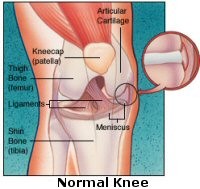Knee Arthroscopy
The following conditions can be assessed and managed via knee arthroscopy.
These often are referred to as tears of the cartilage. The medial and lateral menisci are semilunar fibrous type shock absorbers, which are situated on either side of the knee. Tears in the meniscus are a common cause of knee pain. They sometimes cause intermittent swelling, clicking and catching. Most tears have a degree of degeneration and occur in the part of the cartilage that does not have a blood supply. This means that they are not usually amenable to repair and require removal of the torn unstable fragments. As much of the meniscus is left in position as it does aid in the distribution of loads throughout the knee. A small number of cases, particularly those associated with a cruciate ligament tear occur at the periphery of the cartilage and may be able to be repaired. If this is a possibility then the surgeon will discuss it with you prior to surgery.

Sometimes a piece of bone or cartilage can break off from the surface and cause intermittent locking of the knee. These can be easily removed at surgery.
Some patients with this condition can benefit from a knee arthroscopy. Although this will not change the underlying wear and tear it can sometimes be helpful for acute mechanical symptoms, such as, catching, locking or intermittent swelling.
This is a common cause of anterior knee pain and is often bilateral. Whilst most patients are treated conservatively some patients do benefit from using a motorised shaver to remove unstable areas of articular cartilage behind the knee cap.
Arthroscopy can be used to diagnose and sometimes treat this condition by arthroscopically
removing the inflamed synovial lining.
This diagnosis can usually be made prior to surgery. However, an arthroscopy can sometimes be helpful when diagnosis is not clear cut. An arthroscopy is usually performed in the initial stages of an anterior cruciate ligament reconstruction.
Sometimes a piece of the articular cartilage can be sheared off from the end of the femur bone. This can cause ongoing pain due to the damaged surface. Many patients will benefit from arthroscopic debridement. Newer techniques such as chondrocyte grafting can be used. This procedure can be used for growing a culture of cartilage that is taken from the patient and insertion of a gel like patch to cover the defect. This procedure is relatively new but the results reported so far are very promising. It does involve two operations to the knee, including a second open procedure.
Postoperative Recovery
A cold pack is placed around the knee initially after surgery and you will be instructed to use an ice pack intermittently for the first 2 days. Most patients will be discharged from hospital within 2 to 4 hours. Walking will be initially quite restricted and it is best to rest the knee for the first 2 to 3 days.Car travel can normally be commenced at this time. Some patients will require crutches and you will be instructed to do so if this is necessary. The knee will swell a little after surgery and this is nothing to be concerned about. A crepe bandage will be placed around the knee at the end of the operation and this can be removed on day 3. There will be several waterproof dressings over the arthroscopy portals and these are best left in position until you are reviewed at the 1 week mark postoperatively.
It is important to exercise the knee postoperatively. You will be encouraged to do straight leg raising as well as gentle knee bends. Physiotherapy is only occasionally required.
Follow Up Visit
You will normally be seen between 1 to 2 weeks postoperatively where the video of the operative procedure will be demonstrated to you by Mr Ma or one of his Nursing staff. Your knee will be checked and the dressings removed. Most patients can resume normal activities by 3 to 4 weeks postoperatively. It is also recommended that you work on strengthening your knee by either cycling,swimming or walking. Possible Post Operative Complications Knee arthroscopy is a straight forward operation and most patients obtain good relief of their preoperative symptoms. Following any operative procedure, complications can occur but fortunately following this procedure they are quite uncommon.
This is a rare complication following this operation. If you develop a fever and/or increasing knee pain postoperatively you should contact Mr Ma’s rooms as soon as possible.
Should you develop any significant calf pain or swelling in the first 1 to 2 weeks postoperatively then this may indicate a blood clot in the veins of the lower limb. Once again you should contact Mr Ma’s rooms as soon as possible.
Whilst knee arthroscopy is a very successful procedure, there are some patients who do have
ongoing pain, particularly if there is any significant degenerative arthritis. There is no guarantee with this operation that it is always going to be successful.
Make an Appointment for a Consultation
We are open Monday to Friday from 9-5, except public holidays.